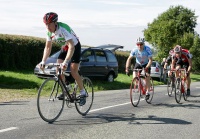|
Advice on getting involved in other clubs'
road races
The basics
 Road
racing is mass-start cycle racing, which is held on either
roads or traffic-free closed circuits such as Darley Moor
and Mallory Park. Race distance can be anything from as little
as twenty miles to in excess of a hundred and fifty. However,
the majority of road races for beginners are approximately
fifty to sixty miles in length. Depending on the race, you
could be riding with as few as twenty other riders or with
over a hundred, which can be a little daunting first time
out - so be prepared! Road
racing is mass-start cycle racing, which is held on either
roads or traffic-free closed circuits such as Darley Moor
and Mallory Park. Race distance can be anything from as little
as twenty miles to in excess of a hundred and fifty. However,
the majority of road races for beginners are approximately
fifty to sixty miles in length. Depending on the race, you
could be riding with as few as twenty other riders or with
over a hundred, which can be a little daunting first time
out - so be prepared!
So how do I get into road racing? There are two ways into
road racing and this is dependent on age. If you are over
forty then you can road race in British
Cycling (BC) events or alternatively in League
of Veteran Racing Cyclists (LVRC) events. If you are under
40 then your only route in is through BC.
To race in BC events, you first need to become a BC member,
which is a fairly benign process. It involves sending off
a form with a fee from anything between £60 for 'Gold' membership
and £34 for 'Silver' membership. You are then entitled to
apply for a race licence, which is an additional £30. So all
in all for the mere cost of £64 you can begin to enter races.
How do I enter races?
First, you need to look at the race
calendar on the BC website and identify races which you
would like to enter. Race season tends to start in March and
goes all the way through to September and providing you are
willing to travel a little distance you can pretty much find
a road race to enter every week of the season.
As a novice to road racing you will automatically be a 4th
category racer, which essentially is the bottom rung of the
ladder. Thus you will only be able to enter races that allow
4th cats. You will find that some races are only for 4th cats
and these are a good place to start. However, the majority
tend to be for 3rd and 4th cat riders only. So now you have
identified some 4th cat races you need to fill in a BC
event entry form which can be found on the BC website
and send it off (with a fee of approximately £10) to the event
organiser, preferably months in advance. Early events tend
to be heavily oversubscribed, so the sooner you get your entry
in the better. However, as the season progresses you find
you can enter either the proceeding weeks or even on the day.
The exception to the rule is closed circuit races, which you
can nearly always 'enter on the line'. If you have entered
prior to the event, you will receive a start sheet detailing
where the race HQ is and various particulars.
What happens on race day?
Always aim to get to the HQ fairly early as this will allow
you time to pick up your race numbers, which you have to pin
to your jersey for identification purposes. You have to remember
two things in particular and that is your club jersey, which
is mandatory, and an approved helmet. Anyone wearing pro-team
replica clothing or with no helmet will be asked to withdraw
… so be warned. The rest is as you might anticipate: you start
in a bunch and after a lead out by the commissaries in the
lead car it's eyeballs out for the duration. In my naïve opinion
it's all about strength and tactics and you require a little
of both to be successful! Depending on what your position
is on finishing, and the type of race that you entered, a
good placing will earn you valuable points on your racing
licence. For example, if you were to have entered the Royal
Sutton Road Race (a regional B race for 3rd and 4th cat riders)
and you won, then you would have attained fifteen points according
to the BC
scoring system.
Once you have attained ten points, you become a 3rd category
rider. Attaining forty promotes you to 2nd category, and so
on till you become an elite rider. As you progress up the
ladder, this then opens up more and more potential races to
you.
|